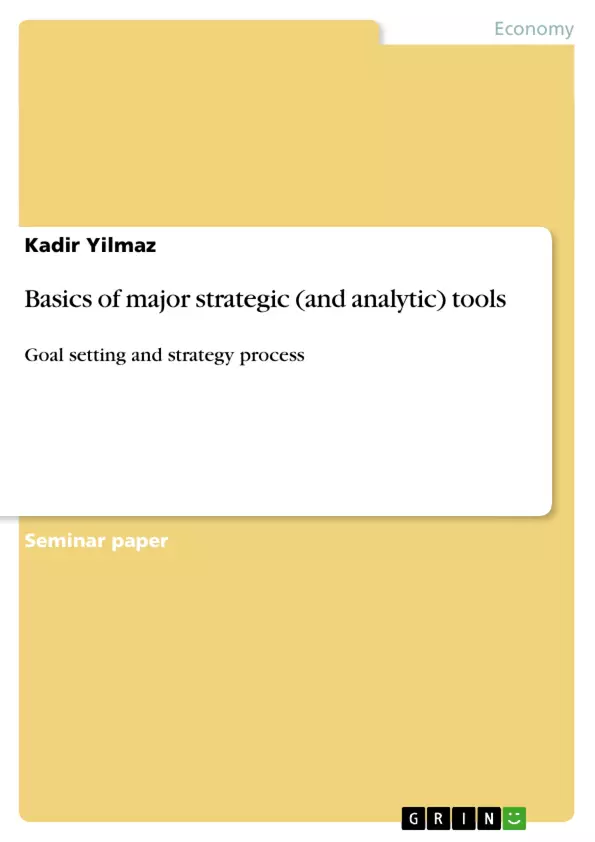Both economic and legal basic conditions force organizations to act efficiently in fulfilling corporate requirements. Factors influencing corporate requirements are fiscal, epidemiological, demographic and technical developments. Time and product quality can be additional objectives. Thus, any organization inevitably interacts with its environment. To achieve desired corporate goals, a strategic master plan that evaluates significant key figures is laid out and implemented by the organization’s management team.
Every strategic discussion begins with an audit that systematically reviews the current efficacy of a business situation in its entirety. Typical questions include the following: “How well does the corporate strategy work for the specific company as a whole, and for its individual business units?”, “Does the strategy gather information and opinions appropriately, and does it help implement strategic measures that win support and, ultimately, result in growth?”, “Does it fail in certain areas?”, “If yes, what are the reasons?”
Inhaltsverzeichnis (Table of Contents)
- Introduction
- External Analysis
- Markets
- McKinsey/GE Growth Share Matrix
- Customer needs
- Industry structure
- Porter's five Forces
- Value Chain Analysis
- Product structure
- Product breakdown
- Product structure views
- Markets
- Internal Analysis
- Resource Audit
- Core Competence Analysis
- Performance Analysis
- Portfolio Analysis
- SWOT Analysis
Zielsetzung und Themenschwerpunkte (Objectives and Key Themes)
This document aims to provide a comprehensive overview of the strategic tools and methodologies employed in business decision-making. The main objective is to equip readers with the knowledge and understanding of various analysis techniques that can be applied to assess a company's current state and shape its future strategic direction.
- Strategic Analysis: The text explores the importance of systematic analysis for effective decision-making within organizations.
- External Analysis: The document examines the external environment's impact on a company's strategic success, including market trends, customer needs, and industry structure.
- Internal Analysis: The document delves into the internal assessment of a company's resources, competencies, and performance to identify strengths and weaknesses.
- Strategic Tools: The text introduces and explains several widely used strategic tools, such as the McKinsey/GE Growth Share Matrix, Porter's Five Forces, and SWOT analysis.
- Strategic Decision-Making: The document emphasizes the role of strategic analysis in formulating and implementing a comprehensive strategic master plan.
Zusammenfassung der Kapitel (Chapter Summaries)
The introduction highlights the importance of strategic analysis in today's competitive business landscape. It emphasizes the need for organizations to adapt and respond to changing external conditions and internal factors. The chapter further lays the groundwork for a structured approach to strategic analysis, emphasizing the need for a comprehensive assessment of both external and internal factors.
The external analysis section delves into the evaluation of various market factors that influence a company's strategic decisions. It examines market attractiveness, competitive strength, and customer needs, with particular focus on the McKinsey/GE Growth Share Matrix, a framework that helps companies assess the attractiveness of different market segments.
The internal analysis chapter focuses on evaluating a company's internal capabilities and resources. It explores various tools and methods, including resource audits, core competence analysis, performance analysis, portfolio analysis, and SWOT analysis. These tools help identify areas for improvement and strategically allocate resources.
Schlüsselwörter (Keywords)
The primary focus of this text lies on strategic analysis and decision-making. Key concepts include external analysis, market attractiveness, competitive strength, customer needs, industry structure, Porter's Five Forces, value chain analysis, internal analysis, resource audit, core competence analysis, performance analysis, portfolio analysis, SWOT analysis, and strategic master plan.
- Quote paper
- Dr. Kadir Yilmaz (Author), 2009, Basics of major strategic (and analytic) tools, Munich, GRIN Verlag, https://www.grin.com/document/135955



